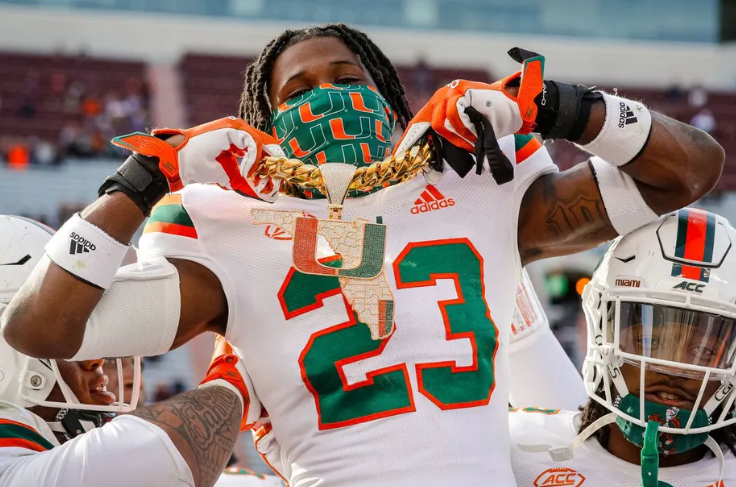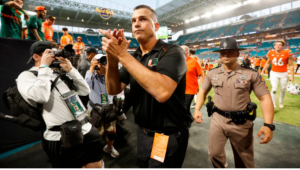

The Miami Hurricanes football program is on the brink of a crucial season, beginning fall camp on Wednesday, precisely one month before they face the Florida Gators in Gainesville on August 31, 2024. This season represents a critical juncture for the Hurricanes, as it marks the start of coach Mario Cristobal’s third year at the helm. After posting a 12-13 record in his first two seasons, Cristobal is under significant pressure to turn the program around and meet the high expectations that have long surrounded Miami football. As the Hurricanes gear up for this pivotal season, several key questions loom large over the program’s prospects for success.
Will Cam Ward Live Up to the Hype?
The addition of quarterback Cam Ward is arguably the most significant storyline heading into the 2024 season. Ward, who transferred from Washington State, chose to forgo the NFL Draft for one final season of college football. His decision was met with considerable excitement and high expectations. Ward’s presence has already generated significant buzz, with some analysts even including him in early Heisman Trophy discussions.
Ward’s performance will be critical in determining whether the Hurricanes can emerge as contenders in the Atlantic Coast Conference (ACC) and potentially secure a spot in the newly expanded 12-team College Football Playoff. The quarterback position is often the linchpin for a team’s success, and Ward’s ability to deliver on the hype will be a major factor in Miami’s fortunes this season. With the expectations placed on him, Ward will need to showcase his talents consistently and provide the stability and playmaking ability that the Hurricanes have been lacking.
Just How Deep Are the Hurricanes at Running Back and Receiver?
Miami’s offensive success will also hinge on the effectiveness and depth of their running back and receiving corps. The Hurricanes have several intriguing options at both positions, but how these players perform and how they are utilized will be crucial.
At running back, the arrival of Oregon State transfer Damien Martinez is a notable development. Martinez is expected to handle the bulk of the carries, bringing a strong and physical running style to the Hurricanes’ backfield. The return of Xavier Restrepo and Jacolby George at receiver adds depth and versatility to the offense. Restrepo is known for his short-yardage reliability and slot presence, while George provides the big-play potential that can stretch defenses.
Beyond these key players, Miami’s depth at running back and receiver will be tested. Both Mark Fletcher and Ajay Allen, who are returning players, missed spring camp due to injuries. Their health and performance will be closely monitored. The addition of Sam Brown from Houston should provide Ward with another viable receiving option. Additionally, the emergence of younger players will play a significant role in shaping the team’s offensive depth. Running backs like Chris Johnson, Chris Wheatley-Humphrey, and Jordan Lyle, as well as receivers such as Bobby Washington, Michael Redding III, Ray Ray Joseph, Joshisa Trader, and Ny Carr, are all expected to contribute.
How Will Miami’s New-Look Secondary Fare?
The Hurricanes face a major challenge in their secondary, with a complete overhaul of their starting lineup from last season. The departures of Kamren Kinchens, James Williams, Jaden Davis, and Davonte Brown leave significant gaps that need to be filled. Kinchens, Williams, and Davis have moved on to the NFL, while Brown has transferred to Florida State. This turnover presents both an opportunity and a challenge for Miami’s defensive backfield.
Fifth-year senior cornerback Daryl Porter Jr., who has experience with Miami after transferring from West Virginia, returns as a key veteran presence. The secondary will also benefit from the addition of defensive back Mishael Powell, a redshirt senior who transferred from Washington, and junior Dyoni Hill from Marshall. Despite these additions, the group is relatively young, with sophomores Damari Brown and Jaden Harris expected to play significant roles. Freshman Zaquan Patterson could also see playing time.
Miami’s secondary struggled last season, ranking 55th nationally in passing yards allowed per game and tied for 53rd in yards allowed per passing attempt. The unit recorded only 12 interceptions, with just three coming from returning players. Powell’s three interceptions from his time at Washington could provide some relief, but overall, the secondary will need to step up significantly to improve on last season’s performance.
How Will the Interior of the Defensive Line Stack Up?
The defensive line is another area where Miami has undergone considerable change. The Hurricanes lost three key players from the interior: Jared Harrison-Hunte (transferred to SMU), Leonard Taylor III (NFL), and Branson Deen (NFL). Replacing these impactful players will be a significant task.
To address this, Miami has brought in several transfers, including C.J. Clark from NC State, Simeon Barrow Jr. from Michigan State, and Marley Cook from Middle Tennessee State. All three are seniors with the experience needed to make an immediate impact. Additionally, freshmen Justin Scott and Armondo Blount, both highly-touted recruits, could also contribute early in their careers.
Despite the loss of key players, the Hurricanes’ front seven should remain strong. Defensive end Rueben Bain Jr., who had an impressive freshman season, is expected to be a standout. Francisco Mauigoa will anchor the linebackers, and the return of defensive end Akeem Mesidor, who missed almost all of last season due to injury, should provide a boost.
Will the Hurricanes Be Able to Integrate Tight Ends into the Passing Game?
One area where Miami struggled last season was the utilization of tight ends in the passing game. The tight ends accounted for only 6.4 percent of receptions and 4.6 percent of receiving yards. This lack of production from the position is something that Cristobal and Ward have identified as a key area for improvement.
Elijah Arroyo, who missed significant time over the past two seasons due to injuries, is expected to play a crucial role in the passing game this year. His health and performance will be essential for Miami’s offensive strategy. Additionally, the Hurricanes have veteran tight end Cam McCormick, who is entering his ninth season, and true freshman Elija Lofton, who could also be a factor in the passing game.
Integrating tight ends more effectively into the offense could provide Ward with additional weapons and create more opportunities for the Hurricanes’ passing attack. The focus on involving tight ends more prominently in the game plan will be an important aspect of Miami’s offensive development.
As Miami Hurricanes football heads into the 2024 season, these questions will be central to the team’s performance and success. The answers to these inquiries will help determine whether the Hurricanes can achieve their goals and make a significant impact in the ACC and on the national stage. With a mix of new additions, returning talent, and key developments, Miami’s football program is poised for a season of high expectations and potential breakthroughs.

Leave a Reply